Category: gui
Python hosting: Host, run, and code Python in the cloud!
QT4 Pixmaps (Images)
In this article we will demonstrate how to load and display images in an PyQT window. We can display images in a PyQT window using the Pixmap widget.

Related course:
Introduction
The constructor of Pixmap takes the image path as parameter:
pixmap = QPixmap(os.getcwd() + 'https://pythonspot-9329.kxcdn.com/logo.png') |
This image needs to be in the same directory as your program. The QPixmap widget supports png and jpeg. Example code below.
PyQT load image in Pixmap
We create a standard QWidget as we have done before. Then we add the QPixmap widget inside which will load the image. The Pixmap is attached to a label which is drawn to the screen.
import os import sys from PyQt4.QtGui import * # Create window app = QApplication(sys.argv) w = QWidget() w.setWindowTitle("PyQT4 Pixmap @ pythonspot.com ") # Create widget label = QLabel(w) pixmap = QPixmap(os.getcwd() + 'https://pythonspot-9329.kxcdn.com/logo.png') label.setPixmap(pixmap) w.resize(pixmap.width(),pixmap.height()) # Draw window w.show() app.exec_() |
Download PyQT Code (Bulk Collection)
Result:

QT4 Progressbar
In this article we will demonstrate how to use the progressbar widget. The progressbar is different from the other widgets in that it updates in time.
Related course:
QT4 Progressbar Example
Let’s start with the code:
#! /usr/bin/env python # -*- coding: utf-8 -*- # import sys from PyQt4.QtGui import * from PyQt4.QtCore import * from PyQt4.QtCore import pyqtSlot,SIGNAL,SLOT class QProgBar(QProgressBar): value = 0 @pyqtSlot() def increaseValue(progressBar): progressBar.setValue(progressBar.value) progressBar.value = progressBar.value+1 # Create an PyQT4 application object. a = QApplication(sys.argv) # The QWidget widget is the base class of all user interface objects in PyQt4. w = QWidget() # Set window size. w.resize(320, 240) # Set window title w.setWindowTitle("PyQT4 Progressbar @ pythonspot.com ") # Create progressBar. bar = QProgBar(w) bar.resize(320,50) bar.setValue(0) bar.move(0,20) # create timer for progressBar timer = QTimer() bar.connect(timer,SIGNAL("timeout()"),bar,SLOT("increaseValue()")) timer.start(400) # Show window w.show() sys.exit(a.exec_()) |
The instance bar (of class QProgBar) is used to hold the value of the progressbar. We call the function setValue() to update its value. The parameter w is given to attach it to the main window. We then move it to position (0,20) on the screen and give it a width and height.
To update the progressbar in time we need a QTimer(). We connect the widget with the timer, which calls the function increaseValue(). We set the timer to repeat the function call every 400 milliseconds. You also see the words SLOT and SIGNAL. If a user does an action such as clicking on a button, typing text in a box – the widget sends out a signal. This signal does nothing, but it can be used to connect with a slot, that acts as a receiver and acts on it.
Result:

Creating a web-browser with Python and PyQT
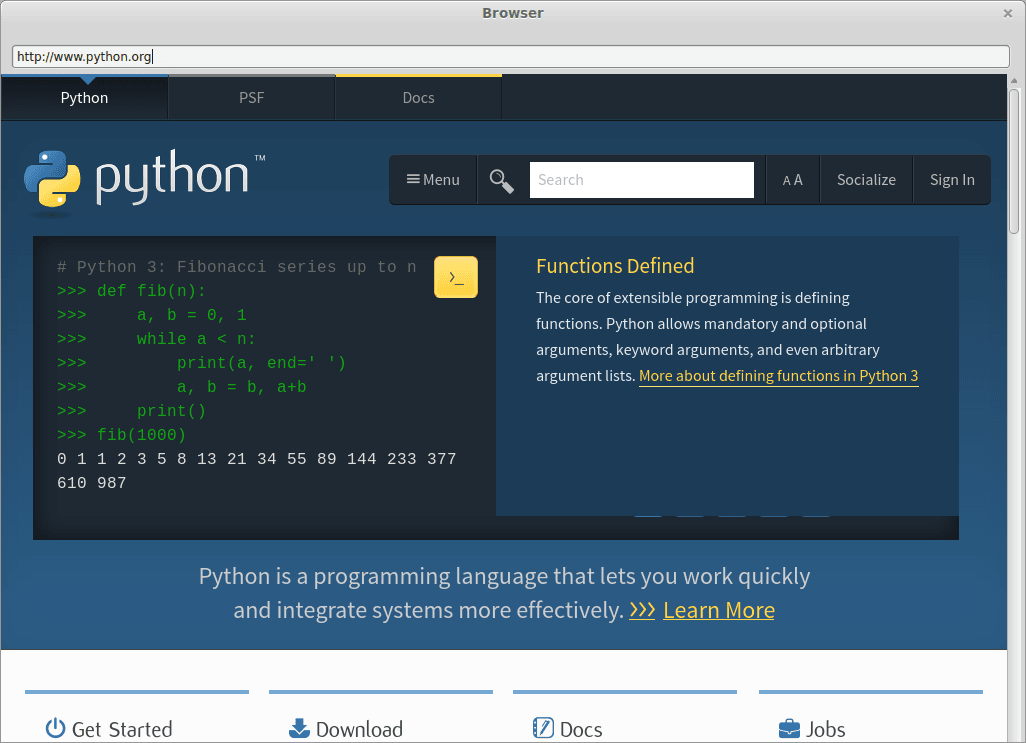
In this tutorial we will build a webbrowser with Python. We will use the PyQT library which has a web component. In this tutorial you will learn how to link all the components together. We will use the default rendering engine and not roll one in this tutorial.
If you have not done our pyqt4 beginner tutorial, you could try it. If python-kde4 cannot be found update your repository to find it. The Ubuntu or Debian install guide .
Related course:
PyQt installation
Install the required packages:
sudo pip install python-qt4 sudo apt-get install qt4-designer sudo apt-get install pyqt4-dev-tools sudo apt-get install python-kde4 |
Creating the GUI with PyQT
Start qt4-designer from your applications menu. The QT Designer application will appear:
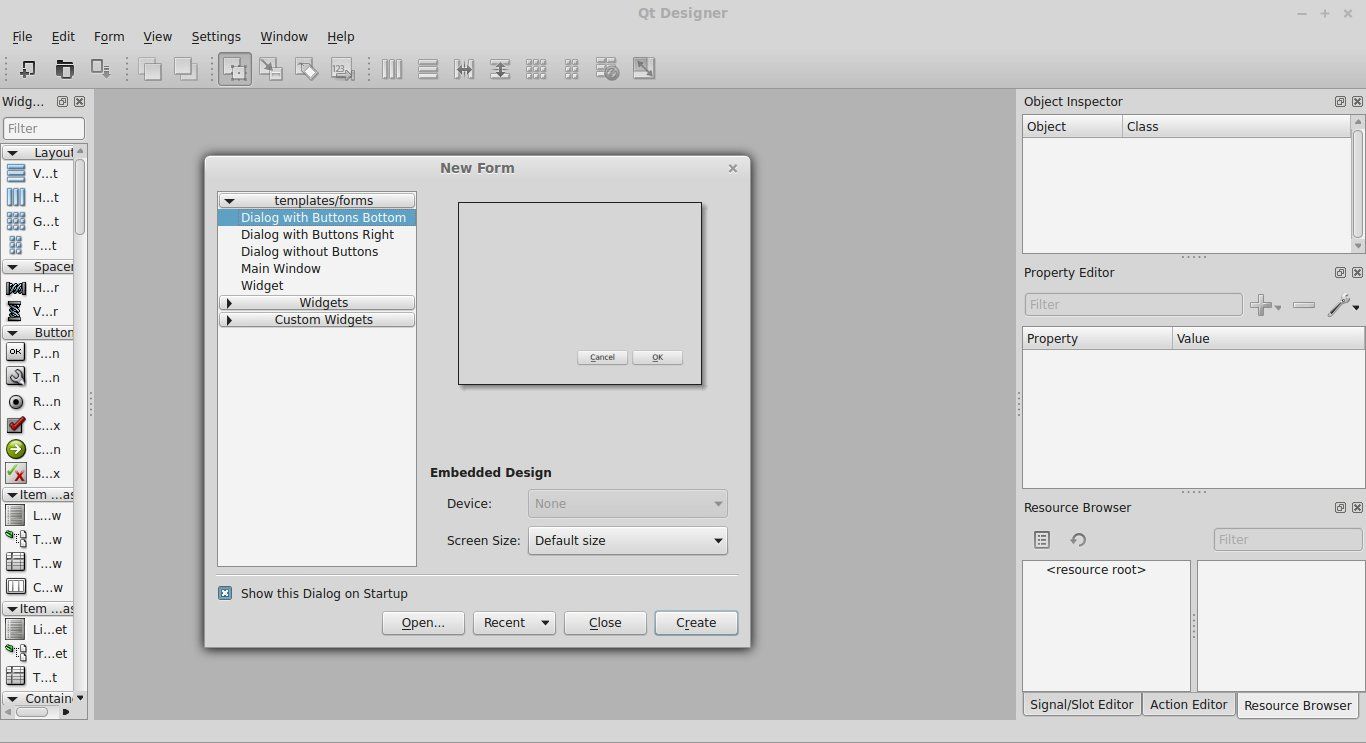
Select Main Window and press Create. We now have our designer window open. Drag a KWebView component on the window. If you have a QtWebView in the component list. use that instead. We also add an Line Edit on top. Press File > Save As > browser.ui. Run the command:
pyuic4 browser.ui > browser.py |
This will generate a Python file. Remove the line “from kwebview import KWebView” from the bottom of the browser.py file. Change KWebView to QtWebView. We want to use QtWebView instead. If you are lazy to change that, take the browser.py file from below.
QWebView exploration
Create a file called run.py with this contents:
import sys from browser import BrowserDialog from PyQt4 import QtCore, QtGui from PyQt4.QtCore import QUrl from PyQt4.QtWebKit import QWebView class MyBrowser(QtGui.QDialog): def __init__(self, parent=None): QtGui.QWidget.__init__(self, parent) QWebView.__init__(self) self.ui = BrowserDialog() self.ui.setupUi(self) self.ui.lineEdit.returnPressed.connect(self.loadURL) def loadURL(self): url = self.ui.lineEdit.text() self.ui.qwebview.load(QUrl(url)) self.show() #self.ui.lineEdit.setText("") if __name__ == "__main__": app = QtGui.QApplication(sys.argv) myapp = MyBrowser() myapp.ui.qwebview.load(QUrl('http://www.pythonspot.com')) myapp.show() sys.exit(app.exec_()) |
This code will use the UI as defined in browser.py and add logic to it. The lines
self.ui.lineEdit.returnPressed.connect(self.loadURL) def loadURL(self): url = self.ui.lineEdit.text() self.ui.qwebview.load(QUrl(url)) self.show() #self.ui.lineEdit.setText("") |
The first line defines the callback or event. If a person presses enter (returnPressed), it will call the function loadURL. It makes sure that once you press enter, the page is loaded with that function. If you did everything correctly, you should be able to run the browser with the command:
python run.py |
Please make sure you type the full url, e.g. : http://pythonspot.com including the http:// part. Your browser should now start:

If your code does not run, please use the codes below (or look at the differences and change whats wrong):
browser.py
# -*- coding: utf-8 -*- # Form implementation generated from reading ui file 'browser.ui' # # Created: Fri Jan 30 20:49:32 2015 # by: PyQt4 UI code generator 4.10.4 # # WARNING! All changes made in this file will be lost! import sys from PyQt4 import QtCore, QtGui from PyQt4.QtGui import QApplication from PyQt4.QtCore import QUrl from PyQt4.QtWebKit import QWebView try: _fromUtf8 = QtCore.QString.fromUtf8 except AttributeError: def _fromUtf8(s): return s try: _encoding = QtGui.QApplication.UnicodeUTF8 def _translate(context, text, disambig): return QtGui.QApplication.translate(context, text, disambig, _encoding) except AttributeError: def _translate(context, text, disambig): return QtGui.QApplication.translate(context, text, disambig) class BrowserDialog(object): def setupUi(self, Dialog): Dialog.setObjectName(_fromUtf8("Dialog")) Dialog.resize(1024, 768) self.qwebview = QWebView(Dialog) self.qwebview.setGeometry(QtCore.QRect(0, 50, 1020, 711)) self.qwebview.setObjectName(_fromUtf8("kwebview")) self.lineEdit = QtGui.QLineEdit(Dialog) self.lineEdit.setGeometry(QtCore.QRect(10, 20, 1000, 25)) self.lineEdit.setObjectName(_fromUtf8("lineEdit")) self.retranslateUi(Dialog) QtCore.QMetaObject.connectSlotsByName(Dialog) def retranslateUi(self, Dialog): Dialog.setWindowTitle(_translate("Browser", "Browser", None)) |
run.py
import sys from browser import BrowserDialog from PyQt4 import QtCore, QtGui from PyQt4.QtCore import QUrl from PyQt4.QtWebKit import QWebView class MyBrowser(QtGui.QDialog): def __init__(self, parent=None): QtGui.QWidget.__init__(self, parent) QWebView.__init__(self) self.ui = BrowserDialog() self.ui.setupUi(self) self.ui.lineEdit.returnPressed.connect(self.loadURL) def loadURL(self): url = self.ui.lineEdit.text() self.ui.qwebview.load(QUrl(url)) self.show() #self.ui.lineEdit.setText("") if __name__ == "__main__": app = QtGui.QApplication(sys.argv) myapp = MyBrowser() myapp.ui.qwebview.load(QUrl('http://www.pythonspot.com')) myapp.show() sys.exit(app.exec_()) |
PyQt4 GUI tutorial
In this tutorial we will teach you how to create a graphical application with PyQT4. This will work on any platform that supports PyQT4 including Windows, Linux, UNIX, Android, OS X and iOS.
Related course:
PyQt4 installation
PyQt does not include Qt itself – you may have to obtain it separately.
The homepage for PyQt is http://www.riverbankcomputing.com/software/pyqt/.
You will need to install some packages:
sudo pip install pyqt sudo apt-get install qt4-designer sudo apt-get install pyqt4-dev-tools sudo apt-get install python-kde4 |
If python-kde4 cannot be found update your repository to find it. If you are on Ubuntu use this link.
Building a PyQT4 GUI
Now we can use the QT Designer application. It saves us from writing tons of layout code that you may be used to when writing HTML. Start qt4-designer from your applications menu. The QT Designer application will appear.
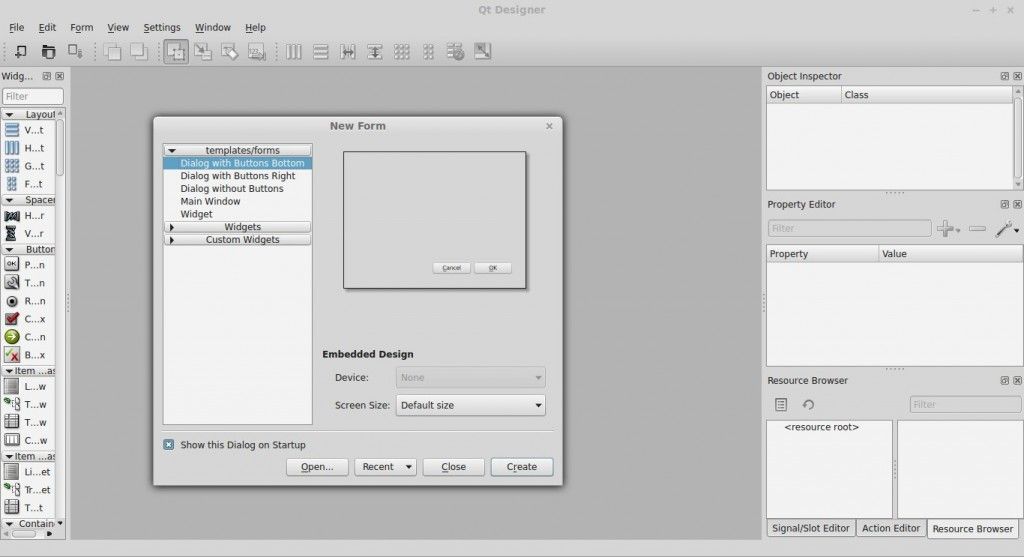
Press Dialog without Buttons and press Create. You can now drag any component from the widget box to the form. Simple drag and drop. We added a button, label and a pixmap. (I took a random image from the web for the pixmap)
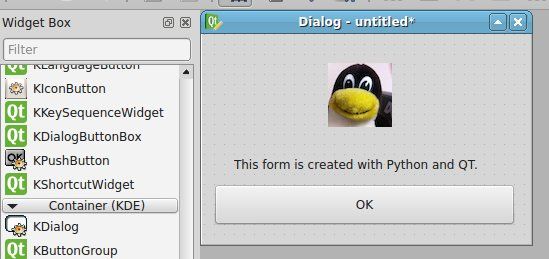
Our window looks like the image above. Press Form > Viewcode. We will get a popup box with the form code in… C++! That is great, but we want the Python code. Press File > Save as > form.ui.
The file test.ui contains your form described in XML format. (You can view it in a text editor) Open a console and type:
pyuic4 form.ui > form.py |
Running the file does nothing. Create a new file called gui.py
Paste the code below:
import sys from PyQt4 import QtCore, QtGui from form import Ui_Dialog class MyDialog(QtGui.QDialog): def __init__(self, parent=None): QtGui.QWidget.__init__(self, parent) self.ui = Ui_Dialog() self.ui.setupUi(self) if __name__ == "__main__": app = QtGui.QApplication(sys.argv) myapp = MyDialog() myapp.show() sys.exit(app.exec_()) |
Run with:
python gui.py |
This will open our graphical interface. Pressing on the OK button will simply close the application.
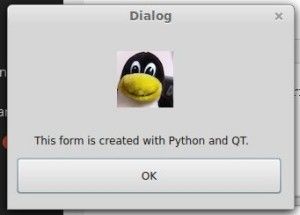
We want to add some action when the OK button is pressed. We add these three lines to the code:
self.ui.pushButton.clicked.connect(self.OK) def OK(self): print 'OK pressed.' |
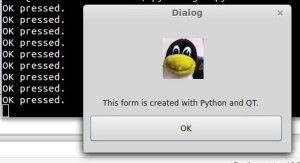
Download PyQT4 Examples (Bulk Collection)
You may like: Create a webbrowser with PyQT4 or PyQt4 Overview
QML and PyQT: Creating a GUI (tutorial)
If you have not done our first PyQT tutorial yet, you should do it, it’s fun! In this tutorial we will use PyQT4 and a user interface markup language, a language that describes the graphical user interfaces and controls .
Related course:
QML and PyQT
An excerpt of user interface markup graphical user interfaces and language code could look like:
Rectangle { id: simplebutton color: "grey" width: 150; height: 75 |
Essentially the language tells what the interface should look like. The language we will be using is called QML.
QTCreator
Start a programmed called QTCreator. The tutorial will be quite graphical to help you through the whole process. Simply type qtcreator in the terminal or start it from the menu list. This screen should pop up:
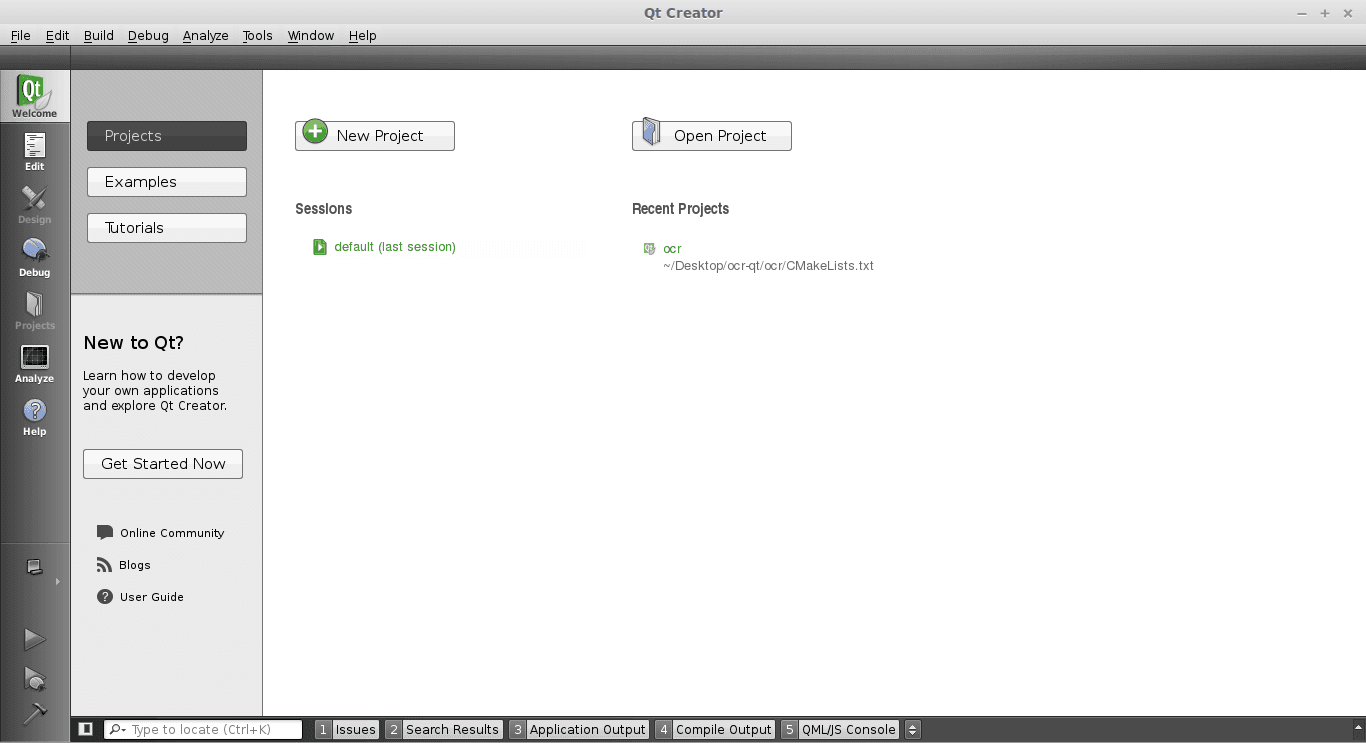
Creating a GUI
Press the big New Project button. Select QT Quick Application from the menu below. Finally press Choose on the bottom right.
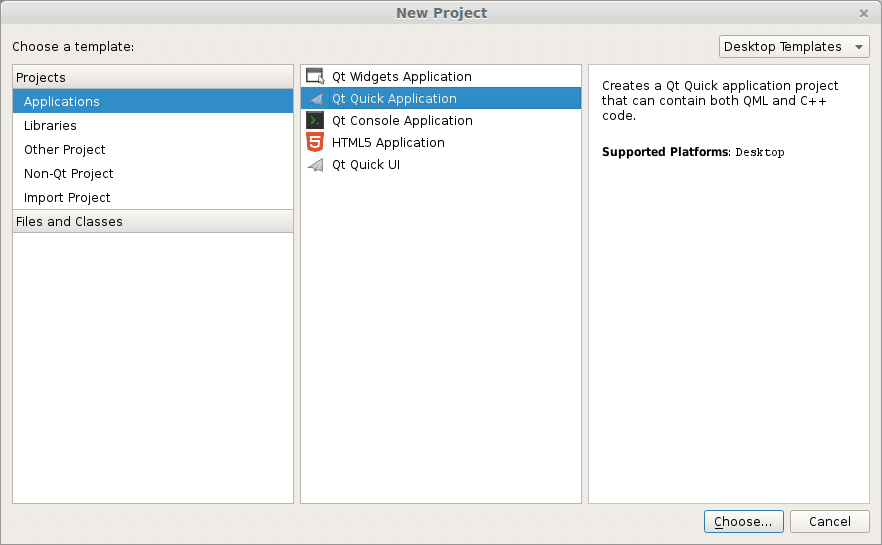
A new popup will appear:
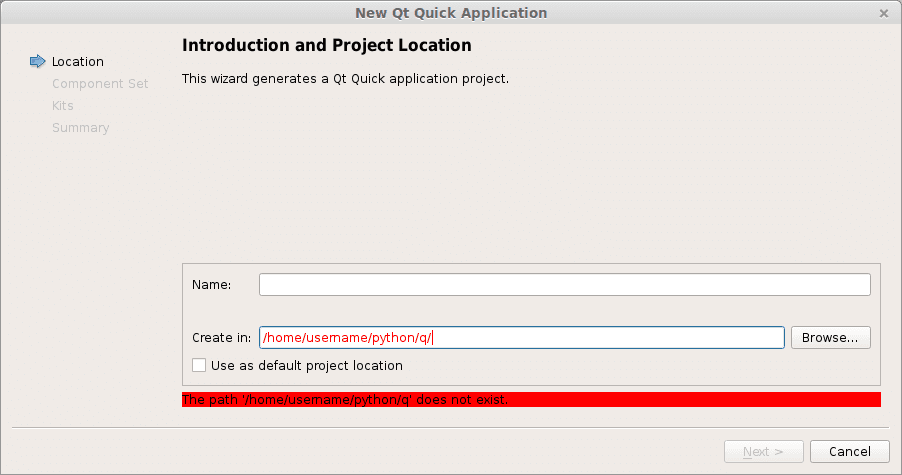
Type a name and a valid path to save your project. Then press Next. Select QT Quick 2.0 from the menu list. Press Next. Press Finish. Immediately a user interface defined in the QML language will appear.
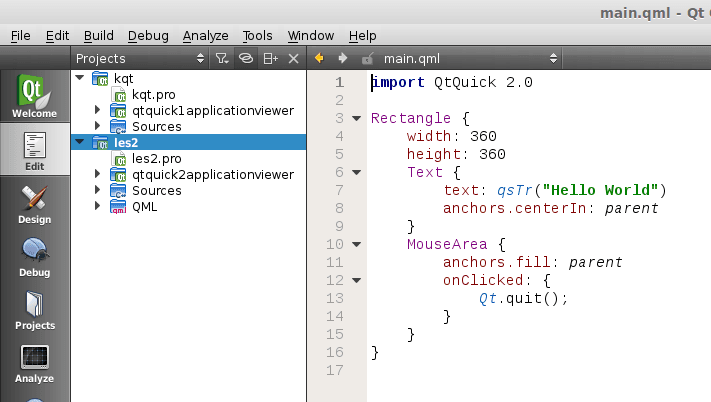
Like all great programmers we are going to solve things the most lazy way possible. Instead of typing all the QML code by hand we are going to press the Design button that is on the left of the screen. A drag and drop screen should appear now.
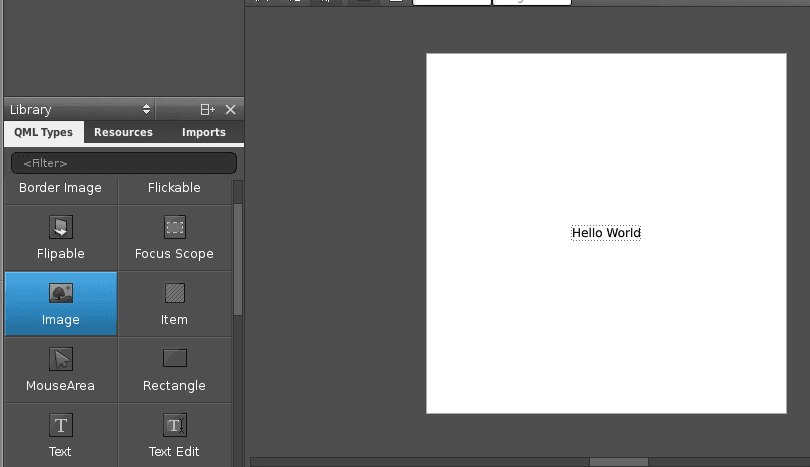
We drag an image onto the area and select the source on the right. Save the project. Open a terminal and locate the qml file you just created. Alternatively you could simply copy the code in the edit box and save it to a .qml file. Enter the command:
qmlviewer main.qml |
This will display the windows as defined in the qml file without any functionality. It is simply a viewer for the interface. We then create some code to load this QML definition:
import sys from PyQt4.QtCore import QDateTime, QObject, QUrl, pyqtSignal from PyQt4.QtGui import QApplication from PyQt4.QtDeclarative import QDeclarativeView app = QApplication(sys.argv) # Create the QML user interface. view = QDeclarativeView() view.setSource(QUrl('main.qml')) view.setResizeMode(QDeclarativeView.SizeRootObjectToView) view.setGeometry(100, 100, 400, 240) view.show() app.exec_() |
Finally we modify the first line main.qml to:
import Qt 4.7 |
Simply because our QtQuick was missing. Running
python run.py |
Will now display our user interface as defined by QML:
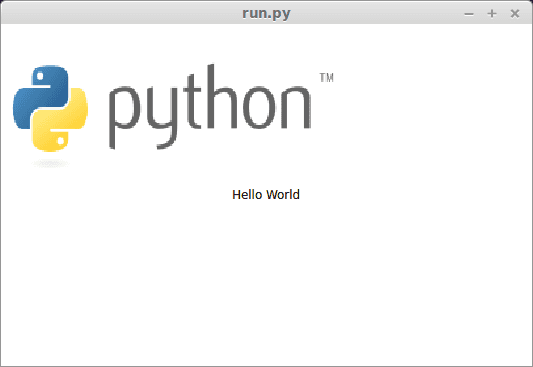
All of the code is simply PyQT, so you could add code like in the previous tutorial. These are the two methods to create a graphical interface with PyQT. This method may be more loosely coupled to the code compared to the method of creating a GUI with QT in the previous tutorial. Despite that both are valid methods.
Download PyQT4 Examples (Bulk Collection)
You may like: Application GUI with PyQT4 or the PyQt4 Tutorials
wxPython GUI tutorial
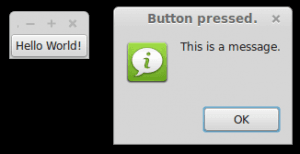
The official wxPython site has several screenshots and downloads for these platforms. wxPython is based on wxWidgets.
Install wxPython
First download and install WxPython, the Python bindings for wxWidgets.
sudo apt-get install python-wxgtk2.8 python-wxtools wx2.8-doc wx2.8-examples wx2.8-headers wx2.8-i18n |
Then install a GUI creator called wxglade:
sudo apt-get install wxglade |
Using a GUI builder such as wxGlade will save you a lot of time, regardless of the GUI library you use. You can easily make complex graphical interfaces because you can simply drag and drop.
Creating our first GUI with Python and wxWidgets:
Start wxglade. You will see its user interface:
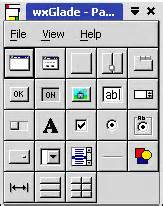
Press on tiny window on the top left, below the file icon.
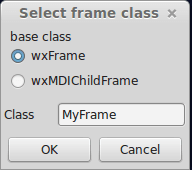
Press OK. An empty window will now appear. Press on the tiny [OK] button in the wxGlade panel and press on the frame. The button will now appear. Press on Application in the tree window.
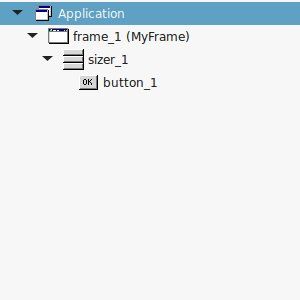
Set the output file in the wxproperties window.
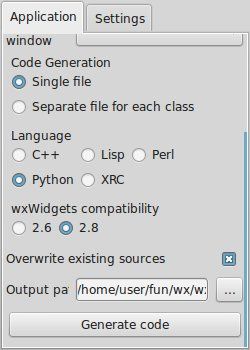
If you look at the window note you can select multiple programming languages and two versions of wxWidgets. Select Python and wxWidgets 2.8. Finally press Generate code. (Do NOT name the file wx.py because the import needs wx, save it as window.py or something else).
Running wxglade code:
Run:
python window.py |
And a window with a button will appear. Pressing the button will not do anything. To start a function when pressing the button, we need to define a so called Callback. This can be as simple as:
def OnButton(self, Event, button_label): print "In OnButton:", button_label |
Finally we bind the button to the callback function using:
self.button_1.Bind(wx.EVT_BUTTON, self.OnButton ) |
Pressing the button will now write a message to the command line. Instead of the boring command line message, we want to show a message box. This can be done using this command:
wx.MessageBox( "This is a message.", "Button pressed."); |
wxPython example code
The full code below:
#!/usr/bin/env python # -*- coding: UTF-8 -*- # # generated by wxGlade 0.6.8 on Fri Jan 23 22:59:56 2015 # import wx # begin wxGlade: dependencies import gettext # end wxGlade # begin wxGlade: extracode # end wxGlade class MyFrame(wx.Frame): def __init__(self, *args, **kwds): # begin wxGlade: MyFrame.__init__ kwds["style"] = wx.DEFAULT_FRAME_STYLE wx.Frame.__init__(self, *args, **kwds) self.button_1 = wx.Button(self, wx.ID_ANY, _("Hello World!")) self.button_1.Bind(wx.EVT_BUTTON, self.OnButton ) self.__set_properties() self.__do_layout() # end wxGlade def __set_properties(self): # begin wxGlade: MyFrame.__set_properties self.SetTitle(_("wxWidgets button example. pythonspot.com ")) # end wxGlade def __do_layout(self): # begin wxGlade: MyFrame.__do_layout sizer_1 = wx.BoxSizer(wx.VERTICAL) sizer_1.Add(self.button_1, 0, 0, 0) self.SetSizer(sizer_1) sizer_1.Fit(self) self.Layout() # end wxGlade def OnButton(event, button_label): wx.MessageBox( "This is a message.", "Button pressed."); # end of class MyFrame if __name__ == "__main__": gettext.install("app") # replace with the appropriate catalog name app = wx.PySimpleApp(0) wx.InitAllImageHandlers() frame_1 = MyFrame(None, wx.ID_ANY, "") app.SetTopWindow(frame_1) frame_1.Show() app.MainLoop() |
